List Of Superfoods
that help boost immune health
This list of superfoods contains only the foods that "earned" their place on it by meeting several requirements which we will be discussing below.
First of all, there are several vitamins and minerals that have a special positive effect on the immunity because they are the cofactors of
Glutathione
production. Their sufficient consumption, according to the studies, delivers a better immune response, which lowers the incidence of infection and may help prevent diseases. These are vitamin C, B-vitamins, folate, vitamin E, and the minerals selenium, magnesium and zinc.
Then, there are foods which contain glutamate, glycine and cysteine - three amino acids that are the building blocks (or precursors) for glutathione. Foods containing these glutathione precursors contribute to immune health - that is why they are on our list of superfoods as well. The only limitimg factor here is that cysteine content in foods is very low and it rarely reaches the cells in the desired undenatured form. You can learn more about cysteine
here.
Then, there are foods rich in
vitamin D
and the cofactors of its production - magnesium and zinc, which are also important for glutathone production. Vitamin D transforms in the body into a hormone responsible for the proper function of the immune system and has been scientifically proven to play a major part in prevention and treatment of many diseases. Note that sunshine still remains the only main source of vitamin D.
And finally, there is a number of foods that truly stand out because of the high nutrient and/or antioxidant content (measured in ORAC units) in them, thus placing them onto the list of superfoods. Incorporating them into your diet daily promotes immune health, too, because extra antioxidants circulting in the body release Glutathione to perform its other important functions, such as DNA repair and elimination of toxins.
I have put together a list of superfoods meeting the above mentioned requirements. We strive to include them all into our menu regularly. To make navigation through these foods easier for you I listed them in alphabetical order.
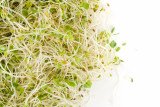 ALFALFA - Alfalfa contains 8 essential enzymes needed to effectively digest food; it is rich in vitamins (A, E, and K) and minerals (calcium, iron, manganese, potassium, magnesium). Alfalfa is also a good plant source of protein (0.5 oz. per 3.5 oz. of weight according to USDA). Alfalfa has been shown to aid in lowering cholesterol and regulating bowels, as well as in getting rid of excess fluids in the body. It helps fight off infections - the chlorophyll in alfalfa develops an effective barrier against bacterial invasion.
ALFALFA - Alfalfa contains 8 essential enzymes needed to effectively digest food; it is rich in vitamins (A, E, and K) and minerals (calcium, iron, manganese, potassium, magnesium). Alfalfa is also a good plant source of protein (0.5 oz. per 3.5 oz. of weight according to USDA). Alfalfa has been shown to aid in lowering cholesterol and regulating bowels, as well as in getting rid of excess fluids in the body. It helps fight off infections - the chlorophyll in alfalfa develops an effective barrier against bacterial invasion.
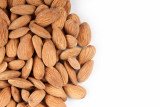 ALMONDS - only one ounce of almonds (about 20-24 shelled whole nuts) contains 35% of daily recommendation amount of vitamin E - a very substantial amount that lands almonds on our list of superfoods. Almonds are also a good source of omega-3 fatty acids - heart-healthy unsaturated fats that lower your bad cholesterol.
ALMONDS - only one ounce of almonds (about 20-24 shelled whole nuts) contains 35% of daily recommendation amount of vitamin E - a very substantial amount that lands almonds on our list of superfoods. Almonds are also a good source of omega-3 fatty acids - heart-healthy unsaturated fats that lower your bad cholesterol.
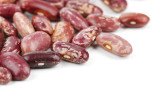 BEANS - Beans or legumes are a good choice when trying to incorporate additional servings of vegetables into your diet. Beans are rich in potassium, B vitamins, and fiber which promotes health of the digestive system. Beans are a source of glutamate and glycine - two of the three precursors for Glutathione production. Cooked beans are low in calories, contain very little fat and are also considered a meat replacement food. As a tip, try substituting beans for meat twice a week. Also, beans contain health-promoting substances called saponins in their cells. Clinical trials suggest that saponins may help lower cholesterol, lower blood glucose responses, and have been shown to have an inverse relationship with the incidence of kidney stones. Isn't it remarkable that beans are even shaped like human kidneys?
BEANS - Beans or legumes are a good choice when trying to incorporate additional servings of vegetables into your diet. Beans are rich in potassium, B vitamins, and fiber which promotes health of the digestive system. Beans are a source of glutamate and glycine - two of the three precursors for Glutathione production. Cooked beans are low in calories, contain very little fat and are also considered a meat replacement food. As a tip, try substituting beans for meat twice a week. Also, beans contain health-promoting substances called saponins in their cells. Clinical trials suggest that saponins may help lower cholesterol, lower blood glucose responses, and have been shown to have an inverse relationship with the incidence of kidney stones. Isn't it remarkable that beans are even shaped like human kidneys?
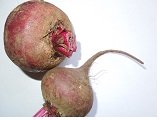 BEETS - Beets are rich in antioxidant phytonutrients named betalains that give beets their characteristic purple-red color. Beets have been studied for their anti-inflammatory and antioxidant properties, and also for their unique ability to assist in the Phase II of the detoxification process (when toxins are being bound to glutathione molecule which neutralizes them and makes them water-soluble and ready for excretion in the urine). Betalains have been scientifically proven to activate glutathione enzymes glutathione-S-transferases (GSTs) which in turn make glutathione molecule attach to toxins. Also, one study on rats showed that beets significantly increase the activity of another glutathione enzyme in the liver – glutathione peroxidase (GPx), and increase the activity of an antioxidant enzyme superoxide dismutase (SOD). In addition to these remarkable glutathione stimulating health benefits, beets are a good source of folate, manganese, potassium, fiber, vitamin C, vitamin B6 and iron.
BEETS - Beets are rich in antioxidant phytonutrients named betalains that give beets their characteristic purple-red color. Beets have been studied for their anti-inflammatory and antioxidant properties, and also for their unique ability to assist in the Phase II of the detoxification process (when toxins are being bound to glutathione molecule which neutralizes them and makes them water-soluble and ready for excretion in the urine). Betalains have been scientifically proven to activate glutathione enzymes glutathione-S-transferases (GSTs) which in turn make glutathione molecule attach to toxins. Also, one study on rats showed that beets significantly increase the activity of another glutathione enzyme in the liver – glutathione peroxidase (GPx), and increase the activity of an antioxidant enzyme superoxide dismutase (SOD). In addition to these remarkable glutathione stimulating health benefits, beets are a good source of folate, manganese, potassium, fiber, vitamin C, vitamin B6 and iron.
 BERRIES - Berries are a highlight of our list of superfoods - they are loaded with vitamin C, potassium and fiber. They have some of the highest antioxidant levels of any fresh fruits. Berries which are deep red and dark blue or purple in color (blueberries, strawberries, blackberries, chokeberries, mulberries) contain very beneficial phytochemicals. Studies have shown that strawberries are involved in inhibiting inflammation enzymes. Plus, berries are simply delicious! Scoop some on top of your cereal in the morning or mix them into your yogurt.
BERRIES - Berries are a highlight of our list of superfoods - they are loaded with vitamin C, potassium and fiber. They have some of the highest antioxidant levels of any fresh fruits. Berries which are deep red and dark blue or purple in color (blueberries, strawberries, blackberries, chokeberries, mulberries) contain very beneficial phytochemicals. Studies have shown that strawberries are involved in inhibiting inflammation enzymes. Plus, berries are simply delicious! Scoop some on top of your cereal in the morning or mix them into your yogurt.
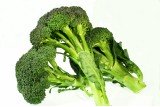 BROCCOLI
- Broccoli is rich in vitamin C and dietary fiber. Small amounts of selenium, a co-factor of Glutathione production, present in broccoli. It is also an excellent source of several compounds and chemicals that have been clinically proven in laboratory and animal studies to have anti-cancer, anti-bacterial and anti-viral properties, and to boost DNA repair in cells. These chemicals are diindolylmethane, glucoraphanin, sulphraphane and indole-3-carbinol (or I3C). All these rich nutritional qualities earn a place on our list of superfoods for this vegetable. The health benefits of broccoli are greatly reduced if it is boiled. Steaming and stir frying do not appear to completely destroy these compounds. Other cruciferous vegetables - cauliflower and Brussels sprouts - contain these beneficial chemicals in them as well but in smaller quantities.
BROCCOLI
- Broccoli is rich in vitamin C and dietary fiber. Small amounts of selenium, a co-factor of Glutathione production, present in broccoli. It is also an excellent source of several compounds and chemicals that have been clinically proven in laboratory and animal studies to have anti-cancer, anti-bacterial and anti-viral properties, and to boost DNA repair in cells. These chemicals are diindolylmethane, glucoraphanin, sulphraphane and indole-3-carbinol (or I3C). All these rich nutritional qualities earn a place on our list of superfoods for this vegetable. The health benefits of broccoli are greatly reduced if it is boiled. Steaming and stir frying do not appear to completely destroy these compounds. Other cruciferous vegetables - cauliflower and Brussels sprouts - contain these beneficial chemicals in them as well but in smaller quantities.
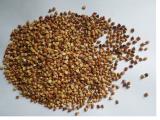 BUCKWHEAT - Despite its name buckwheat is a gluten free grain and has nothing to do with wheat. This grain is related to rhubarb and is a food staple in the Eastern European countries such as Ukraine and Poland, and rightly so. One serving of buckwheat provides 25% of your daily requirement for the glutathione cofactors vitamin B1 and 4% of B2, as well as 15% of vitamin B3, 20% of magnesium and 6% of zinc, not to mention 20% of dietary fiber, plus folate, manganese, iron and phosphorus. In addition, buckwheat contains all amino acids (including glutamate, glycine and cysteine for glutathione production). It is also a good source of the bioflavonoid rutin. It can be served both cold (in salads) or hot as a side dish or in soups. The cooking instructions are the same as in Quinoa below.
BUCKWHEAT - Despite its name buckwheat is a gluten free grain and has nothing to do with wheat. This grain is related to rhubarb and is a food staple in the Eastern European countries such as Ukraine and Poland, and rightly so. One serving of buckwheat provides 25% of your daily requirement for the glutathione cofactors vitamin B1 and 4% of B2, as well as 15% of vitamin B3, 20% of magnesium and 6% of zinc, not to mention 20% of dietary fiber, plus folate, manganese, iron and phosphorus. In addition, buckwheat contains all amino acids (including glutamate, glycine and cysteine for glutathione production). It is also a good source of the bioflavonoid rutin. It can be served both cold (in salads) or hot as a side dish or in soups. The cooking instructions are the same as in Quinoa below.
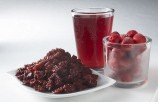 CHERRIES (tart) - Tart (sour) cherries are on our list of superfoods because they are the only natural source of
Melatonin
in the amounts that can effect your health: melatonin helps increase your master antioxidant Glutathione and helps regulate sleep. These dark colored cherries are also rich in anthocyanins - compounds inhibiting COX enzymes which are responsible for pain sensations. It is very difficult to find fresh sour cherries even during season, so they are available as dried or frozen cherries, and tart cherry juice concentrate which preserves perfectly all the goodness of this fruit.
CHERRIES (tart) - Tart (sour) cherries are on our list of superfoods because they are the only natural source of
Melatonin
in the amounts that can effect your health: melatonin helps increase your master antioxidant Glutathione and helps regulate sleep. These dark colored cherries are also rich in anthocyanins - compounds inhibiting COX enzymes which are responsible for pain sensations. It is very difficult to find fresh sour cherries even during season, so they are available as dried or frozen cherries, and tart cherry juice concentrate which preserves perfectly all the goodness of this fruit.
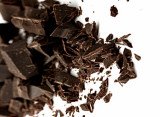 CHOCOLATE - It is on the list of superfoods because cocoa powder used in the production of chocolate has very high antioxidant capacity measured in ORAC, even higher than blueberries, strawberries and garlic. Antioxidants found in cocoa enhance vascular function and decrease platelet stickiness contributing to cardiovascular health. Just remember to choose dark semi-sweet chocolate with cocoa content not less than 70%, the higher the better - upto 95%. But please do not make the whole bar disappear in one sitting! Pure 100% cocoa powder can be added to smoothies or cereals for extra antioxidants.
CHOCOLATE - It is on the list of superfoods because cocoa powder used in the production of chocolate has very high antioxidant capacity measured in ORAC, even higher than blueberries, strawberries and garlic. Antioxidants found in cocoa enhance vascular function and decrease platelet stickiness contributing to cardiovascular health. Just remember to choose dark semi-sweet chocolate with cocoa content not less than 70%, the higher the better - upto 95%. But please do not make the whole bar disappear in one sitting! Pure 100% cocoa powder can be added to smoothies or cereals for extra antioxidants.
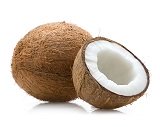 COCONUTS - Coconuts are among the most nutritionally dense foods rich in glutathione boosting vitamins and trace minerals. Over 50% of coconut fat is lauric acid, an immune-boosting fat shown to be beneficial for support of heart health, thyroid function, cognitive function and more. Your body converts lauric acid into monolaurin which possesses powerful anti-viral, anti-bacterial and anti-fungal properties. Coconut oil is also 2/3 medium chain fatty acids that your liver easily converts into energy rather than it being stored there as fat. Coconut oil digests easily, too, putting no strain on your pancreas and liver. In addition to these health benefits of coconut oil, coconut meat (100g or 3.5 oz.) contains 52% RDA of fiber, 19% iron, 8% potassium, 20% vitamin B5, 9% magnesium, 12% zinc, 4% vitamin C, 4% vitamin B6 and 6% vitamin B1 – the latter five all being important co-factors of glutathione production.
COCONUTS - Coconuts are among the most nutritionally dense foods rich in glutathione boosting vitamins and trace minerals. Over 50% of coconut fat is lauric acid, an immune-boosting fat shown to be beneficial for support of heart health, thyroid function, cognitive function and more. Your body converts lauric acid into monolaurin which possesses powerful anti-viral, anti-bacterial and anti-fungal properties. Coconut oil is also 2/3 medium chain fatty acids that your liver easily converts into energy rather than it being stored there as fat. Coconut oil digests easily, too, putting no strain on your pancreas and liver. In addition to these health benefits of coconut oil, coconut meat (100g or 3.5 oz.) contains 52% RDA of fiber, 19% iron, 8% potassium, 20% vitamin B5, 9% magnesium, 12% zinc, 4% vitamin C, 4% vitamin B6 and 6% vitamin B1 – the latter five all being important co-factors of glutathione production.
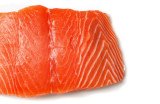 FISH - Fish is a good source of easily digested protein, low in saturated fat, rich in omega-3 fatty acids. Omega-3 enriched diets are associated with the reduction in incidence of heart attacks, and higher fish intakes (salmon, trout, herring, cod, tuna, and sardines) were associated in several studies with a lower incidence of coronary artery disease and cardiovascular mortality. Overall it has been shown that a minimum of one fish meal a week on a regular basis translates into a 52% reduction in sudden cardiac death. Fish is on the list of superfoods because it is also one of the very few sources of vitamin D, and a good source of glutamate and glycine - glutathione building blocks. Wild caught salmon is also an excellent source of astaxanthin, a carotenoid and a potent antioxidant that gives this fish its distinct pink-orange color. Astaxanthin has been shown in many animal studies and human trials to be beneficial for cardiovascular health, eye health, strength and endurance, cholesterol management, and immune health through the mechanism of improving the action of glutathione enzymes, retention of glutathione levels and significant reduction of oxidative stress. More details on our pages
What is astaxanthin?
and
Astaxanthin and glutathione.
FISH - Fish is a good source of easily digested protein, low in saturated fat, rich in omega-3 fatty acids. Omega-3 enriched diets are associated with the reduction in incidence of heart attacks, and higher fish intakes (salmon, trout, herring, cod, tuna, and sardines) were associated in several studies with a lower incidence of coronary artery disease and cardiovascular mortality. Overall it has been shown that a minimum of one fish meal a week on a regular basis translates into a 52% reduction in sudden cardiac death. Fish is on the list of superfoods because it is also one of the very few sources of vitamin D, and a good source of glutamate and glycine - glutathione building blocks. Wild caught salmon is also an excellent source of astaxanthin, a carotenoid and a potent antioxidant that gives this fish its distinct pink-orange color. Astaxanthin has been shown in many animal studies and human trials to be beneficial for cardiovascular health, eye health, strength and endurance, cholesterol management, and immune health through the mechanism of improving the action of glutathione enzymes, retention of glutathione levels and significant reduction of oxidative stress. More details on our pages
What is astaxanthin?
and
Astaxanthin and glutathione.
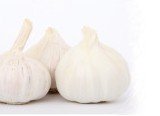 GARLIC - In addition to wide culinary uses garlic is also well known for its medicinal properties backed by extensive research. Garlic has scientifically documented antibacterial, antifungal, antiviral and anti-inflammatory properties and that puts it right onto our list of superfoods. Garlic boosts immune system, helps reduce blood clotting and blood pressure, helps reduce cholesterol. Garlic contains small amounts of cysteine, one of the three precursors for Glutathione production. It is a good idea to add fresh garlic to your everyday diet, especially during winter flu season. We usually chop some on top of our salads every day at dinner. A good tip: for enzymes in garlic to be activated you must cut or chop it before adding it to the dishes you cook. Chewing would do it if you prefer to eat it raw without cutting it. Just don't eat it on an empty stomach as it may cause irritation.
GARLIC - In addition to wide culinary uses garlic is also well known for its medicinal properties backed by extensive research. Garlic has scientifically documented antibacterial, antifungal, antiviral and anti-inflammatory properties and that puts it right onto our list of superfoods. Garlic boosts immune system, helps reduce blood clotting and blood pressure, helps reduce cholesterol. Garlic contains small amounts of cysteine, one of the three precursors for Glutathione production. It is a good idea to add fresh garlic to your everyday diet, especially during winter flu season. We usually chop some on top of our salads every day at dinner. A good tip: for enzymes in garlic to be activated you must cut or chop it before adding it to the dishes you cook. Chewing would do it if you prefer to eat it raw without cutting it. Just don't eat it on an empty stomach as it may cause irritation.
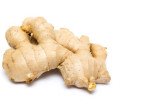 GINGER - Just like garlic ginger is both a culinary spice and a medicinal superfood. It acts as an antioxidant and has antibacterial, anti-inflammatory and anti-clotting properties. It has been shown to improve liver function, digestion and help lower cholesterol. Ginger has also been used to treat motion sickness and nausea. It is important to remember not to eat ginger on an empty stomach as it may cause irritation, too, like garlic.
GINGER - Just like garlic ginger is both a culinary spice and a medicinal superfood. It acts as an antioxidant and has antibacterial, anti-inflammatory and anti-clotting properties. It has been shown to improve liver function, digestion and help lower cholesterol. Ginger has also been used to treat motion sickness and nausea. It is important to remember not to eat ginger on an empty stomach as it may cause irritation, too, like garlic.
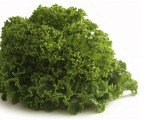 KALE - You often see kale used as a background decoration for serving sandwiches or shrimp at buffet parties, and it gets thrown out afterwards. It also adorns flower beds in summer. However, kale is very rich in antioxidant nutrients and should be added to your menu. Kale is very high in beta-carotene (vitamin A forming carotene), lutein and zeaxanthin (other two carotenoids considered beneficial for maintaining good eye health), vitamin C, vitamin K and calcium. Tip: kale has very hard stems, so before cooking it or chopping it into your salad, remove the stems completely even out of the leaf part itself. Kale freezes well too, and freezing actually adds a bit of sweetness to the taste. Because of high vitamin K content in this plant, people taking anti-coagulant drugs should avoid eating kale.
KALE - You often see kale used as a background decoration for serving sandwiches or shrimp at buffet parties, and it gets thrown out afterwards. It also adorns flower beds in summer. However, kale is very rich in antioxidant nutrients and should be added to your menu. Kale is very high in beta-carotene (vitamin A forming carotene), lutein and zeaxanthin (other two carotenoids considered beneficial for maintaining good eye health), vitamin C, vitamin K and calcium. Tip: kale has very hard stems, so before cooking it or chopping it into your salad, remove the stems completely even out of the leaf part itself. Kale freezes well too, and freezing actually adds a bit of sweetness to the taste. Because of high vitamin K content in this plant, people taking anti-coagulant drugs should avoid eating kale.
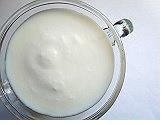 KEFIR (raw) - Kefir is a fermented probiotic milk drink made by communities of lactic acid bacteria and yeasts called "kefir grains". These kefir grains look like soft cauliflower florets, and can be placed in cow's, goat's or sheep's milk to make kefir. The taste of kefir is mildly to strongly sour depending on the length of fermentation, usually 12-24 hours at room temperature. In the process of fermentation of lactose kefir grains produce dozens of varieties of highly beneficial probiotic bacteria which assist in maintaining the health of the digestive system, and improving absorbtion of vitamins and nutrients from food - perfect reason to be on the list of superfoods. Kefir is reported to be well tolerated by lactose intolerant people, because kefir grains consume most of lactose from milk. The best milk to make kefir is raw unpasteurized milk which contains all the nutrients, vitamins and enzymes including those necessary for proper lactose digestion that are destroyed by pasteurization (lactose intolerance is actually intolerance of pasteurized milk lacking enzymes - something that FDA and the milk industry do not want us to know). Kefir is sold commercially at health food stores and some supermarkets, but it is of course pasteurized, and probiotics, usually only 4 or 5 varieties are then added back to it along with sugar, flavorings and food dye to make it more appealing to consumers. This is not the kefir you want to drink to boost your immune health. The best way to experience all the health benefits of kefir containing a multitude of live probiotic cultures is to purchase kefir grains from a local dairy farm or online and make your own kefir - a simple process where the only thing you have to do is to put the grains into a fresh batch of milk every day. Kefir can be also used to make delicious whole grain sourdough bread, pizza crust, or cream cheese.
Find a raw dairy farm near you (in USA).
KEFIR (raw) - Kefir is a fermented probiotic milk drink made by communities of lactic acid bacteria and yeasts called "kefir grains". These kefir grains look like soft cauliflower florets, and can be placed in cow's, goat's or sheep's milk to make kefir. The taste of kefir is mildly to strongly sour depending on the length of fermentation, usually 12-24 hours at room temperature. In the process of fermentation of lactose kefir grains produce dozens of varieties of highly beneficial probiotic bacteria which assist in maintaining the health of the digestive system, and improving absorbtion of vitamins and nutrients from food - perfect reason to be on the list of superfoods. Kefir is reported to be well tolerated by lactose intolerant people, because kefir grains consume most of lactose from milk. The best milk to make kefir is raw unpasteurized milk which contains all the nutrients, vitamins and enzymes including those necessary for proper lactose digestion that are destroyed by pasteurization (lactose intolerance is actually intolerance of pasteurized milk lacking enzymes - something that FDA and the milk industry do not want us to know). Kefir is sold commercially at health food stores and some supermarkets, but it is of course pasteurized, and probiotics, usually only 4 or 5 varieties are then added back to it along with sugar, flavorings and food dye to make it more appealing to consumers. This is not the kefir you want to drink to boost your immune health. The best way to experience all the health benefits of kefir containing a multitude of live probiotic cultures is to purchase kefir grains from a local dairy farm or online and make your own kefir - a simple process where the only thing you have to do is to put the grains into a fresh batch of milk every day. Kefir can be also used to make delicious whole grain sourdough bread, pizza crust, or cream cheese.
Find a raw dairy farm near you (in USA).
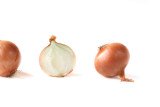 ONIONS - Phenol and flavonoid compounds in raw onions are well known for their antioxidant properties that strengthen immune health that's why onions are on our list of superfoods. Mild tasting varieties have lesser antioxidant activity than those that "bite". Onions are also one of the few sources of cysteine, an all important glutathione building block.
ONIONS - Phenol and flavonoid compounds in raw onions are well known for their antioxidant properties that strengthen immune health that's why onions are on our list of superfoods. Mild tasting varieties have lesser antioxidant activity than those that "bite". Onions are also one of the few sources of cysteine, an all important glutathione building block.
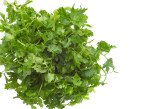 PARSLEY - Fresh parsley is a great source of vitamin C, it is also rich in vitamin K, iron, zinc, folate, magnesium and dietary fiber - meeting quite a few requirements for the list of superfoods. However, as with kale, because of very high vitamin K content, parsley should be avoided by those taking anti-coagulants and by pregnant women as parsley oils could lead to stimulation of uterus and preterm labor. One or two sprigs on a salad should not be a problem though (if you are pregnant ask your doctor if eating parsley is ok for you in case you are at risk for miscarriage).
PARSLEY - Fresh parsley is a great source of vitamin C, it is also rich in vitamin K, iron, zinc, folate, magnesium and dietary fiber - meeting quite a few requirements for the list of superfoods. However, as with kale, because of very high vitamin K content, parsley should be avoided by those taking anti-coagulants and by pregnant women as parsley oils could lead to stimulation of uterus and preterm labor. One or two sprigs on a salad should not be a problem though (if you are pregnant ask your doctor if eating parsley is ok for you in case you are at risk for miscarriage).
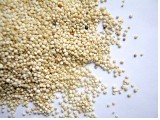 QUINOA - Quinoa (pronounced /'keenwa/) is a grain native of South America. It can be cooked pretty much like rice but has much higher nutritional value than any other grain. Quinoa is rich in vitamins B1, B2, B6 and E, folate, iron, magnesium, zinc, selenium, and phosphorus. The most remarkable thing about quinoa is that it contains all amino acids (including glutamate, glycine and cysteine for Glutathione production) in such proportions as to make quinoa a complete protein - very unusual among plant foods. The protein content of quinoa is very high (14%). It is gluten-free, so it is very easy to digest. Quinoa is also a good source of dietary fiber. All these nutritional qualities make quinoa a must, in my opinion, for a well balanced diet aimed at improving immune health, so it is here on our list of superfoods.
QUINOA - Quinoa (pronounced /'keenwa/) is a grain native of South America. It can be cooked pretty much like rice but has much higher nutritional value than any other grain. Quinoa is rich in vitamins B1, B2, B6 and E, folate, iron, magnesium, zinc, selenium, and phosphorus. The most remarkable thing about quinoa is that it contains all amino acids (including glutamate, glycine and cysteine for Glutathione production) in such proportions as to make quinoa a complete protein - very unusual among plant foods. The protein content of quinoa is very high (14%). It is gluten-free, so it is very easy to digest. Quinoa is also a good source of dietary fiber. All these nutritional qualities make quinoa a must, in my opinion, for a well balanced diet aimed at improving immune health, so it is here on our list of superfoods.
Quinoa in its natural state has a coating of bitter-tasting saponins that need to be removed before cooking. Soaking quinoa in water for 2 hours before cooking and rinsing it well under running water in a fine strainer will do that. Most packaged quinoa available at supermarkets has saponins already removed (check the packaging).
Cooking quinoa: bring two cups of water to a boil, add one cup of quinoa, cover and simmer on low for about 15-20 minutes until water is gone, fluff up with a fork and serve. It can be boiled in vegetable or chicken broth to add flavor. Quinoa can be eaten as is or mixed with steamed greens (spinach, kale, broccoli), fried mushrooms, added to cold salads; for nutritious breakfast - mixed with a bit of honey, almonds, dried tart cherries, raisins or fresh berries. Bon appetit!
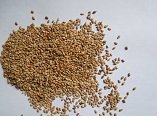 SESAME SEEDS - Toasted sesame seeds are a great source of all three glutathione building blocks: glutamate, glycine and cysteine. They are also a real magnesium and zinc powerhouse with 97% and 75% of RDA respectively per 3.5 oz. – both of these are important glutathione cofactors, as well as cofactors of vitamin D production. Other nutrients that are abundant in toasted sesame seeds are iron, phosphorus and calcium. They are a very good source of plant protein too, at almost 17g per 3.5 oz.
SESAME SEEDS - Toasted sesame seeds are a great source of all three glutathione building blocks: glutamate, glycine and cysteine. They are also a real magnesium and zinc powerhouse with 97% and 75% of RDA respectively per 3.5 oz. – both of these are important glutathione cofactors, as well as cofactors of vitamin D production. Other nutrients that are abundant in toasted sesame seeds are iron, phosphorus and calcium. They are a very good source of plant protein too, at almost 17g per 3.5 oz.
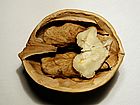 WALNUTS - Walnuts are rich in quite a few nutrients that are very important to your immune health. They contain vitamins B1, B2, B6, E, folate, and selenium necessary for the production of glutahtione. All amino acids are present in walnuts including glutathione precursors glutamate, glycine and cysteine. Walnuts are also rich in two most important cofactors of vitamin D - magnesium and zinc, which are both necessary for proper functioning of glutathione as well. Other nutrients present in walnuts in significant quantities are iron, phosphorus, copper, manganese, potassium, lutein and zeaxanthin, and omega-3 fatty acids. Moderate amounts of
Melatonin
are also present in walnuts. And they are rich in fiber and protein. All these facts make walnuts a real nutrition powerhouse destined to be included on the list of superfoods. Make sure you add them to your menu - in salads, cereals, yogurt, trail mix, baking!
WALNUTS - Walnuts are rich in quite a few nutrients that are very important to your immune health. They contain vitamins B1, B2, B6, E, folate, and selenium necessary for the production of glutahtione. All amino acids are present in walnuts including glutathione precursors glutamate, glycine and cysteine. Walnuts are also rich in two most important cofactors of vitamin D - magnesium and zinc, which are both necessary for proper functioning of glutathione as well. Other nutrients present in walnuts in significant quantities are iron, phosphorus, copper, manganese, potassium, lutein and zeaxanthin, and omega-3 fatty acids. Moderate amounts of
Melatonin
are also present in walnuts. And they are rich in fiber and protein. All these facts make walnuts a real nutrition powerhouse destined to be included on the list of superfoods. Make sure you add them to your menu - in salads, cereals, yogurt, trail mix, baking!
Check out what other foods, besides tart cherries and walnuts, contain melatonin -
Foods With Melatonin.
Read about glutathione content in foods on our page
Glutathione Foods.
Read about foods with magnesium on our page
Foods High In Magnesium.
Read about foods with selenium on our page
High Selenium Foods.
Is honey better than sugar? Do sugars suppress immune system?
Our list of superfoods may not be complete but it does include most of the foods that meet our above mentioned requirements for foods that boost immune system.
And remember that if any particular foods - be it oranges, carrots, grapes, or exotic berries like goji - make you feel well and full of energy, put them on your own list of superfoods because they work for you.
Return to Top of List Of Superfoods
Return to Foods That Boost Immune System
Return to Foods with Melatonin
Return to Natural immune system boosters
Return to Home







 ALFALFA - Alfalfa contains 8 essential enzymes needed to effectively digest food; it is rich in vitamins (A, E, and K) and minerals (calcium, iron, manganese, potassium, magnesium). Alfalfa is also a good plant source of protein (0.5 oz. per 3.5 oz. of weight according to USDA). Alfalfa has been shown to aid in lowering cholesterol and regulating bowels, as well as in getting rid of excess fluids in the body. It helps fight off infections - the chlorophyll in alfalfa develops an effective barrier against bacterial invasion.
ALFALFA - Alfalfa contains 8 essential enzymes needed to effectively digest food; it is rich in vitamins (A, E, and K) and minerals (calcium, iron, manganese, potassium, magnesium). Alfalfa is also a good plant source of protein (0.5 oz. per 3.5 oz. of weight according to USDA). Alfalfa has been shown to aid in lowering cholesterol and regulating bowels, as well as in getting rid of excess fluids in the body. It helps fight off infections - the chlorophyll in alfalfa develops an effective barrier against bacterial invasion. ALMONDS - only one ounce of almonds (about 20-24 shelled whole nuts) contains 35% of daily recommendation amount of vitamin E - a very substantial amount that lands almonds on our list of superfoods. Almonds are also a good source of omega-3 fatty acids - heart-healthy unsaturated fats that lower your bad cholesterol.
ALMONDS - only one ounce of almonds (about 20-24 shelled whole nuts) contains 35% of daily recommendation amount of vitamin E - a very substantial amount that lands almonds on our list of superfoods. Almonds are also a good source of omega-3 fatty acids - heart-healthy unsaturated fats that lower your bad cholesterol. BEANS - Beans or legumes are a good choice when trying to incorporate additional servings of vegetables into your diet. Beans are rich in potassium, B vitamins, and fiber which promotes health of the digestive system. Beans are a source of glutamate and glycine - two of the three precursors for Glutathione production. Cooked beans are low in calories, contain very little fat and are also considered a meat replacement food. As a tip, try substituting beans for meat twice a week. Also, beans contain health-promoting substances called saponins in their cells. Clinical trials suggest that saponins may help lower cholesterol, lower blood glucose responses, and have been shown to have an inverse relationship with the incidence of kidney stones. Isn't it remarkable that beans are even shaped like human kidneys?
BEANS - Beans or legumes are a good choice when trying to incorporate additional servings of vegetables into your diet. Beans are rich in potassium, B vitamins, and fiber which promotes health of the digestive system. Beans are a source of glutamate and glycine - two of the three precursors for Glutathione production. Cooked beans are low in calories, contain very little fat and are also considered a meat replacement food. As a tip, try substituting beans for meat twice a week. Also, beans contain health-promoting substances called saponins in their cells. Clinical trials suggest that saponins may help lower cholesterol, lower blood glucose responses, and have been shown to have an inverse relationship with the incidence of kidney stones. Isn't it remarkable that beans are even shaped like human kidneys? BEETS - Beets are rich in antioxidant phytonutrients named betalains that give beets their characteristic purple-red color. Beets have been studied for their anti-inflammatory and antioxidant properties, and also for their unique ability to assist in the Phase II of the detoxification process (when toxins are being bound to glutathione molecule which neutralizes them and makes them water-soluble and ready for excretion in the urine). Betalains have been scientifically proven to activate glutathione enzymes glutathione-S-transferases (GSTs) which in turn make glutathione molecule attach to toxins. Also, one study on rats showed that beets significantly increase the activity of another glutathione enzyme in the liver – glutathione peroxidase (GPx), and increase the activity of an antioxidant enzyme superoxide dismutase (SOD). In addition to these remarkable glutathione stimulating health benefits, beets are a good source of folate, manganese, potassium, fiber, vitamin C, vitamin B6 and iron.
BEETS - Beets are rich in antioxidant phytonutrients named betalains that give beets their characteristic purple-red color. Beets have been studied for their anti-inflammatory and antioxidant properties, and also for their unique ability to assist in the Phase II of the detoxification process (when toxins are being bound to glutathione molecule which neutralizes them and makes them water-soluble and ready for excretion in the urine). Betalains have been scientifically proven to activate glutathione enzymes glutathione-S-transferases (GSTs) which in turn make glutathione molecule attach to toxins. Also, one study on rats showed that beets significantly increase the activity of another glutathione enzyme in the liver – glutathione peroxidase (GPx), and increase the activity of an antioxidant enzyme superoxide dismutase (SOD). In addition to these remarkable glutathione stimulating health benefits, beets are a good source of folate, manganese, potassium, fiber, vitamin C, vitamin B6 and iron. BERRIES - Berries are a highlight of our list of superfoods - they are loaded with vitamin C, potassium and fiber. They have some of the highest antioxidant levels of any fresh fruits. Berries which are deep red and dark blue or purple in color (blueberries, strawberries, blackberries, chokeberries, mulberries) contain very beneficial phytochemicals. Studies have shown that strawberries are involved in inhibiting inflammation enzymes. Plus, berries are simply delicious! Scoop some on top of your cereal in the morning or mix them into your yogurt.
BERRIES - Berries are a highlight of our list of superfoods - they are loaded with vitamin C, potassium and fiber. They have some of the highest antioxidant levels of any fresh fruits. Berries which are deep red and dark blue or purple in color (blueberries, strawberries, blackberries, chokeberries, mulberries) contain very beneficial phytochemicals. Studies have shown that strawberries are involved in inhibiting inflammation enzymes. Plus, berries are simply delicious! Scoop some on top of your cereal in the morning or mix them into your yogurt.
 BUCKWHEAT - Despite its name buckwheat is a gluten free grain and has nothing to do with wheat. This grain is related to rhubarb and is a food staple in the Eastern European countries such as Ukraine and Poland, and rightly so. One serving of buckwheat provides 25% of your daily requirement for the glutathione cofactors vitamin B1 and 4% of B2, as well as 15% of vitamin B3, 20% of magnesium and 6% of zinc, not to mention 20% of dietary fiber, plus folate, manganese, iron and phosphorus. In addition, buckwheat contains all amino acids (including glutamate, glycine and cysteine for glutathione production). It is also a good source of the bioflavonoid rutin. It can be served both cold (in salads) or hot as a side dish or in soups. The cooking instructions are the same as in Quinoa below.
BUCKWHEAT - Despite its name buckwheat is a gluten free grain and has nothing to do with wheat. This grain is related to rhubarb and is a food staple in the Eastern European countries such as Ukraine and Poland, and rightly so. One serving of buckwheat provides 25% of your daily requirement for the glutathione cofactors vitamin B1 and 4% of B2, as well as 15% of vitamin B3, 20% of magnesium and 6% of zinc, not to mention 20% of dietary fiber, plus folate, manganese, iron and phosphorus. In addition, buckwheat contains all amino acids (including glutamate, glycine and cysteine for glutathione production). It is also a good source of the bioflavonoid rutin. It can be served both cold (in salads) or hot as a side dish or in soups. The cooking instructions are the same as in Quinoa below. CHERRIES (tart) - Tart (sour) cherries are on our list of superfoods because they are the only natural source of
CHERRIES (tart) - Tart (sour) cherries are on our list of superfoods because they are the only natural source of
 CHOCOLATE - It is on the list of superfoods because cocoa powder used in the production of chocolate has very high antioxidant capacity measured in ORAC, even higher than blueberries, strawberries and garlic. Antioxidants found in cocoa enhance vascular function and decrease platelet stickiness contributing to cardiovascular health. Just remember to choose dark semi-sweet chocolate with cocoa content not less than 70%, the higher the better - upto 95%. But please do not make the whole bar disappear in one sitting! Pure 100% cocoa powder can be added to smoothies or cereals for extra antioxidants.
CHOCOLATE - It is on the list of superfoods because cocoa powder used in the production of chocolate has very high antioxidant capacity measured in ORAC, even higher than blueberries, strawberries and garlic. Antioxidants found in cocoa enhance vascular function and decrease platelet stickiness contributing to cardiovascular health. Just remember to choose dark semi-sweet chocolate with cocoa content not less than 70%, the higher the better - upto 95%. But please do not make the whole bar disappear in one sitting! Pure 100% cocoa powder can be added to smoothies or cereals for extra antioxidants. COCONUTS - Coconuts are among the most nutritionally dense foods rich in glutathione boosting vitamins and trace minerals. Over 50% of coconut fat is lauric acid, an immune-boosting fat shown to be beneficial for support of heart health, thyroid function, cognitive function and more. Your body converts lauric acid into monolaurin which possesses powerful anti-viral, anti-bacterial and anti-fungal properties. Coconut oil is also 2/3 medium chain fatty acids that your liver easily converts into energy rather than it being stored there as fat. Coconut oil digests easily, too, putting no strain on your pancreas and liver. In addition to these health benefits of coconut oil, coconut meat (100g or 3.5 oz.) contains 52% RDA of fiber, 19% iron, 8% potassium, 20% vitamin B5, 9% magnesium, 12% zinc, 4% vitamin C, 4% vitamin B6 and 6% vitamin B1 – the latter five all being important co-factors of glutathione production.
COCONUTS - Coconuts are among the most nutritionally dense foods rich in glutathione boosting vitamins and trace minerals. Over 50% of coconut fat is lauric acid, an immune-boosting fat shown to be beneficial for support of heart health, thyroid function, cognitive function and more. Your body converts lauric acid into monolaurin which possesses powerful anti-viral, anti-bacterial and anti-fungal properties. Coconut oil is also 2/3 medium chain fatty acids that your liver easily converts into energy rather than it being stored there as fat. Coconut oil digests easily, too, putting no strain on your pancreas and liver. In addition to these health benefits of coconut oil, coconut meat (100g or 3.5 oz.) contains 52% RDA of fiber, 19% iron, 8% potassium, 20% vitamin B5, 9% magnesium, 12% zinc, 4% vitamin C, 4% vitamin B6 and 6% vitamin B1 – the latter five all being important co-factors of glutathione production. FISH - Fish is a good source of easily digested protein, low in saturated fat, rich in omega-3 fatty acids. Omega-3 enriched diets are associated with the reduction in incidence of heart attacks, and higher fish intakes (salmon, trout, herring, cod, tuna, and sardines) were associated in several studies with a lower incidence of coronary artery disease and cardiovascular mortality. Overall it has been shown that a minimum of one fish meal a week on a regular basis translates into a 52% reduction in sudden cardiac death. Fish is on the list of superfoods because it is also one of the very few sources of vitamin D, and a good source of glutamate and glycine - glutathione building blocks. Wild caught salmon is also an excellent source of astaxanthin, a carotenoid and a potent antioxidant that gives this fish its distinct pink-orange color. Astaxanthin has been shown in many animal studies and human trials to be beneficial for cardiovascular health, eye health, strength and endurance, cholesterol management, and immune health through the mechanism of improving the action of glutathione enzymes, retention of glutathione levels and significant reduction of oxidative stress. More details on our pages
FISH - Fish is a good source of easily digested protein, low in saturated fat, rich in omega-3 fatty acids. Omega-3 enriched diets are associated with the reduction in incidence of heart attacks, and higher fish intakes (salmon, trout, herring, cod, tuna, and sardines) were associated in several studies with a lower incidence of coronary artery disease and cardiovascular mortality. Overall it has been shown that a minimum of one fish meal a week on a regular basis translates into a 52% reduction in sudden cardiac death. Fish is on the list of superfoods because it is also one of the very few sources of vitamin D, and a good source of glutamate and glycine - glutathione building blocks. Wild caught salmon is also an excellent source of astaxanthin, a carotenoid and a potent antioxidant that gives this fish its distinct pink-orange color. Astaxanthin has been shown in many animal studies and human trials to be beneficial for cardiovascular health, eye health, strength and endurance, cholesterol management, and immune health through the mechanism of improving the action of glutathione enzymes, retention of glutathione levels and significant reduction of oxidative stress. More details on our pages
 GARLIC - In addition to wide culinary uses garlic is also well known for its medicinal properties backed by extensive research. Garlic has scientifically documented antibacterial, antifungal, antiviral and anti-inflammatory properties and that puts it right onto our list of superfoods. Garlic boosts immune system, helps reduce blood clotting and blood pressure, helps reduce cholesterol. Garlic contains small amounts of cysteine, one of the three precursors for Glutathione production. It is a good idea to add fresh garlic to your everyday diet, especially during winter flu season. We usually chop some on top of our salads every day at dinner. A good tip: for enzymes in garlic to be activated you must cut or chop it before adding it to the dishes you cook. Chewing would do it if you prefer to eat it raw without cutting it. Just don't eat it on an empty stomach as it may cause irritation.
GARLIC - In addition to wide culinary uses garlic is also well known for its medicinal properties backed by extensive research. Garlic has scientifically documented antibacterial, antifungal, antiviral and anti-inflammatory properties and that puts it right onto our list of superfoods. Garlic boosts immune system, helps reduce blood clotting and blood pressure, helps reduce cholesterol. Garlic contains small amounts of cysteine, one of the three precursors for Glutathione production. It is a good idea to add fresh garlic to your everyday diet, especially during winter flu season. We usually chop some on top of our salads every day at dinner. A good tip: for enzymes in garlic to be activated you must cut or chop it before adding it to the dishes you cook. Chewing would do it if you prefer to eat it raw without cutting it. Just don't eat it on an empty stomach as it may cause irritation. GINGER - Just like garlic ginger is both a culinary spice and a medicinal superfood. It acts as an antioxidant and has antibacterial, anti-inflammatory and anti-clotting properties. It has been shown to improve liver function, digestion and help lower cholesterol. Ginger has also been used to treat motion sickness and nausea. It is important to remember not to eat ginger on an empty stomach as it may cause irritation, too, like garlic.
GINGER - Just like garlic ginger is both a culinary spice and a medicinal superfood. It acts as an antioxidant and has antibacterial, anti-inflammatory and anti-clotting properties. It has been shown to improve liver function, digestion and help lower cholesterol. Ginger has also been used to treat motion sickness and nausea. It is important to remember not to eat ginger on an empty stomach as it may cause irritation, too, like garlic. KALE - You often see kale used as a background decoration for serving sandwiches or shrimp at buffet parties, and it gets thrown out afterwards. It also adorns flower beds in summer. However, kale is very rich in antioxidant nutrients and should be added to your menu. Kale is very high in beta-carotene (vitamin A forming carotene), lutein and zeaxanthin (other two carotenoids considered beneficial for maintaining good eye health), vitamin C, vitamin K and calcium. Tip: kale has very hard stems, so before cooking it or chopping it into your salad, remove the stems completely even out of the leaf part itself. Kale freezes well too, and freezing actually adds a bit of sweetness to the taste. Because of high vitamin K content in this plant, people taking anti-coagulant drugs should avoid eating kale.
KALE - You often see kale used as a background decoration for serving sandwiches or shrimp at buffet parties, and it gets thrown out afterwards. It also adorns flower beds in summer. However, kale is very rich in antioxidant nutrients and should be added to your menu. Kale is very high in beta-carotene (vitamin A forming carotene), lutein and zeaxanthin (other two carotenoids considered beneficial for maintaining good eye health), vitamin C, vitamin K and calcium. Tip: kale has very hard stems, so before cooking it or chopping it into your salad, remove the stems completely even out of the leaf part itself. Kale freezes well too, and freezing actually adds a bit of sweetness to the taste. Because of high vitamin K content in this plant, people taking anti-coagulant drugs should avoid eating kale. KEFIR (raw) - Kefir is a fermented probiotic milk drink made by communities of lactic acid bacteria and yeasts called "kefir grains". These kefir grains look like soft cauliflower florets, and can be placed in cow's, goat's or sheep's milk to make kefir. The taste of kefir is mildly to strongly sour depending on the length of fermentation, usually 12-24 hours at room temperature. In the process of fermentation of lactose kefir grains produce dozens of varieties of highly beneficial probiotic bacteria which assist in maintaining the health of the digestive system, and improving absorbtion of vitamins and nutrients from food - perfect reason to be on the list of superfoods. Kefir is reported to be well tolerated by lactose intolerant people, because kefir grains consume most of lactose from milk. The best milk to make kefir is raw unpasteurized milk which contains all the nutrients, vitamins and enzymes including those necessary for proper lactose digestion that are destroyed by pasteurization (lactose intolerance is actually intolerance of pasteurized milk lacking enzymes - something that FDA and the milk industry do not want us to know). Kefir is sold commercially at health food stores and some supermarkets, but it is of course pasteurized, and probiotics, usually only 4 or 5 varieties are then added back to it along with sugar, flavorings and food dye to make it more appealing to consumers. This is not the kefir you want to drink to boost your immune health. The best way to experience all the health benefits of kefir containing a multitude of live probiotic cultures is to purchase kefir grains from a local dairy farm or online and make your own kefir - a simple process where the only thing you have to do is to put the grains into a fresh batch of milk every day. Kefir can be also used to make delicious whole grain sourdough bread, pizza crust, or cream cheese.
KEFIR (raw) - Kefir is a fermented probiotic milk drink made by communities of lactic acid bacteria and yeasts called "kefir grains". These kefir grains look like soft cauliflower florets, and can be placed in cow's, goat's or sheep's milk to make kefir. The taste of kefir is mildly to strongly sour depending on the length of fermentation, usually 12-24 hours at room temperature. In the process of fermentation of lactose kefir grains produce dozens of varieties of highly beneficial probiotic bacteria which assist in maintaining the health of the digestive system, and improving absorbtion of vitamins and nutrients from food - perfect reason to be on the list of superfoods. Kefir is reported to be well tolerated by lactose intolerant people, because kefir grains consume most of lactose from milk. The best milk to make kefir is raw unpasteurized milk which contains all the nutrients, vitamins and enzymes including those necessary for proper lactose digestion that are destroyed by pasteurization (lactose intolerance is actually intolerance of pasteurized milk lacking enzymes - something that FDA and the milk industry do not want us to know). Kefir is sold commercially at health food stores and some supermarkets, but it is of course pasteurized, and probiotics, usually only 4 or 5 varieties are then added back to it along with sugar, flavorings and food dye to make it more appealing to consumers. This is not the kefir you want to drink to boost your immune health. The best way to experience all the health benefits of kefir containing a multitude of live probiotic cultures is to purchase kefir grains from a local dairy farm or online and make your own kefir - a simple process where the only thing you have to do is to put the grains into a fresh batch of milk every day. Kefir can be also used to make delicious whole grain sourdough bread, pizza crust, or cream cheese.
 ONIONS - Phenol and flavonoid compounds in raw onions are well known for their antioxidant properties that strengthen immune health that's why onions are on our list of superfoods. Mild tasting varieties have lesser antioxidant activity than those that "bite". Onions are also one of the few sources of cysteine, an all important glutathione building block.
ONIONS - Phenol and flavonoid compounds in raw onions are well known for their antioxidant properties that strengthen immune health that's why onions are on our list of superfoods. Mild tasting varieties have lesser antioxidant activity than those that "bite". Onions are also one of the few sources of cysteine, an all important glutathione building block.  PARSLEY - Fresh parsley is a great source of vitamin C, it is also rich in vitamin K, iron, zinc, folate, magnesium and dietary fiber - meeting quite a few requirements for the list of superfoods. However, as with kale, because of very high vitamin K content, parsley should be avoided by those taking anti-coagulants and by pregnant women as parsley oils could lead to stimulation of uterus and preterm labor. One or two sprigs on a salad should not be a problem though (if you are pregnant ask your doctor if eating parsley is ok for you in case you are at risk for miscarriage).
PARSLEY - Fresh parsley is a great source of vitamin C, it is also rich in vitamin K, iron, zinc, folate, magnesium and dietary fiber - meeting quite a few requirements for the list of superfoods. However, as with kale, because of very high vitamin K content, parsley should be avoided by those taking anti-coagulants and by pregnant women as parsley oils could lead to stimulation of uterus and preterm labor. One or two sprigs on a salad should not be a problem though (if you are pregnant ask your doctor if eating parsley is ok for you in case you are at risk for miscarriage). QUINOA - Quinoa (pronounced /'keenwa/) is a grain native of South America. It can be cooked pretty much like rice but has much higher nutritional value than any other grain. Quinoa is rich in vitamins B1, B2, B6 and E, folate, iron, magnesium, zinc, selenium, and phosphorus. The most remarkable thing about quinoa is that it contains all amino acids (including glutamate, glycine and cysteine for Glutathione production) in such proportions as to make quinoa a complete protein - very unusual among plant foods. The protein content of quinoa is very high (14%). It is gluten-free, so it is very easy to digest. Quinoa is also a good source of dietary fiber. All these nutritional qualities make quinoa a must, in my opinion, for a well balanced diet aimed at improving immune health, so it is here on our list of superfoods.
QUINOA - Quinoa (pronounced /'keenwa/) is a grain native of South America. It can be cooked pretty much like rice but has much higher nutritional value than any other grain. Quinoa is rich in vitamins B1, B2, B6 and E, folate, iron, magnesium, zinc, selenium, and phosphorus. The most remarkable thing about quinoa is that it contains all amino acids (including glutamate, glycine and cysteine for Glutathione production) in such proportions as to make quinoa a complete protein - very unusual among plant foods. The protein content of quinoa is very high (14%). It is gluten-free, so it is very easy to digest. Quinoa is also a good source of dietary fiber. All these nutritional qualities make quinoa a must, in my opinion, for a well balanced diet aimed at improving immune health, so it is here on our list of superfoods.
 SESAME SEEDS - Toasted sesame seeds are a great source of all three glutathione building blocks: glutamate, glycine and cysteine. They are also a real magnesium and zinc powerhouse with 97% and 75% of RDA respectively per 3.5 oz. – both of these are important glutathione cofactors, as well as cofactors of vitamin D production. Other nutrients that are abundant in toasted sesame seeds are iron, phosphorus and calcium. They are a very good source of plant protein too, at almost 17g per 3.5 oz.
SESAME SEEDS - Toasted sesame seeds are a great source of all three glutathione building blocks: glutamate, glycine and cysteine. They are also a real magnesium and zinc powerhouse with 97% and 75% of RDA respectively per 3.5 oz. – both of these are important glutathione cofactors, as well as cofactors of vitamin D production. Other nutrients that are abundant in toasted sesame seeds are iron, phosphorus and calcium. They are a very good source of plant protein too, at almost 17g per 3.5 oz.  WALNUTS - Walnuts are rich in quite a few nutrients that are very important to your immune health. They contain vitamins B1, B2, B6, E, folate, and selenium necessary for the production of glutahtione. All amino acids are present in walnuts including glutathione precursors glutamate, glycine and cysteine. Walnuts are also rich in two most important cofactors of vitamin D - magnesium and zinc, which are both necessary for proper functioning of glutathione as well. Other nutrients present in walnuts in significant quantities are iron, phosphorus, copper, manganese, potassium, lutein and zeaxanthin, and omega-3 fatty acids. Moderate amounts of
WALNUTS - Walnuts are rich in quite a few nutrients that are very important to your immune health. They contain vitamins B1, B2, B6, E, folate, and selenium necessary for the production of glutahtione. All amino acids are present in walnuts including glutathione precursors glutamate, glycine and cysteine. Walnuts are also rich in two most important cofactors of vitamin D - magnesium and zinc, which are both necessary for proper functioning of glutathione as well. Other nutrients present in walnuts in significant quantities are iron, phosphorus, copper, manganese, potassium, lutein and zeaxanthin, and omega-3 fatty acids. Moderate amounts of
